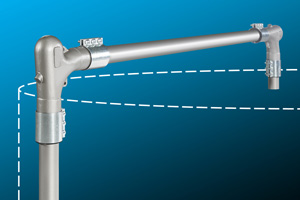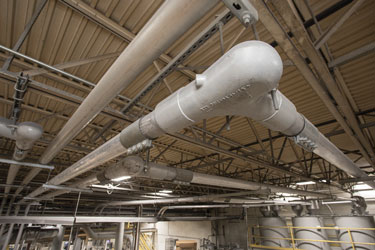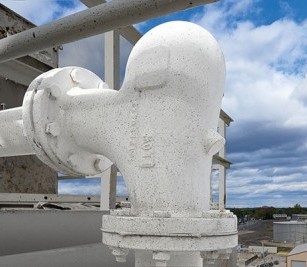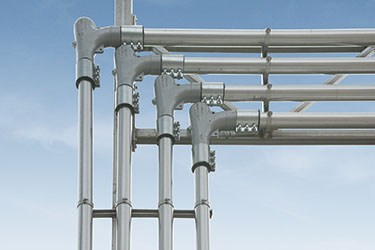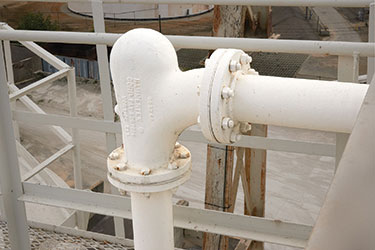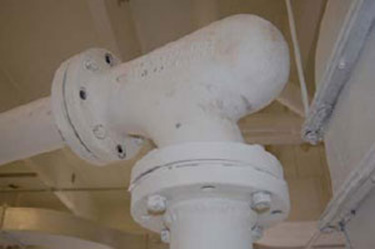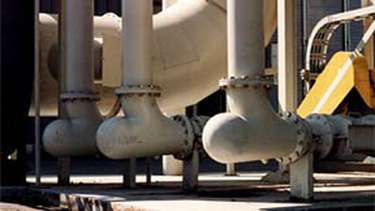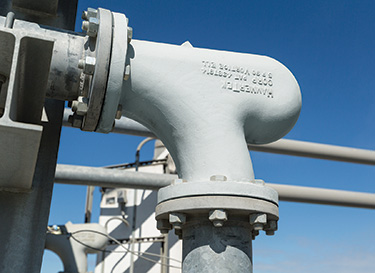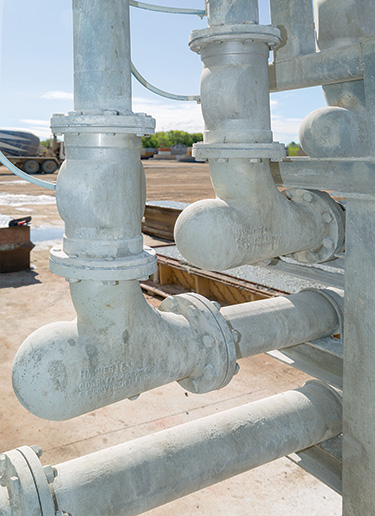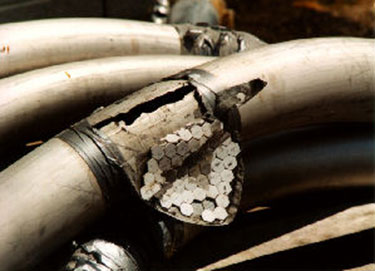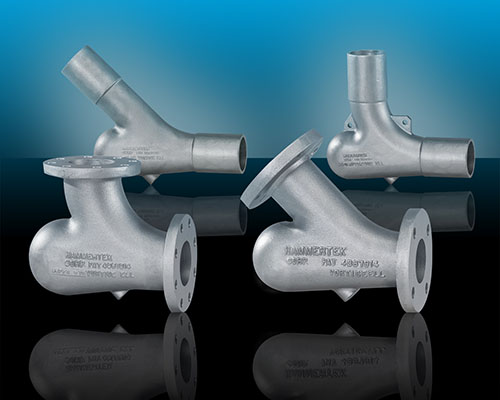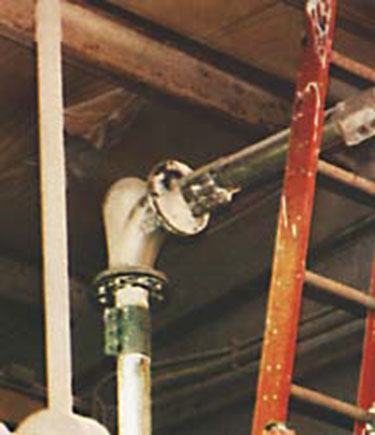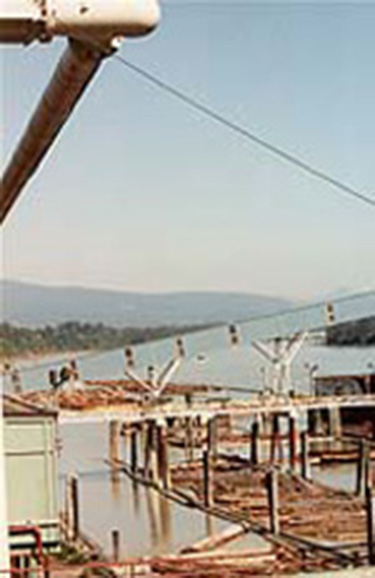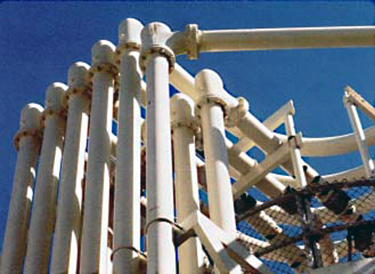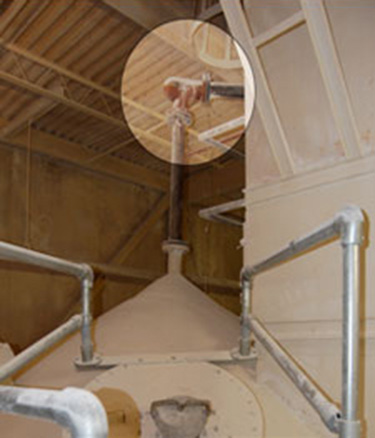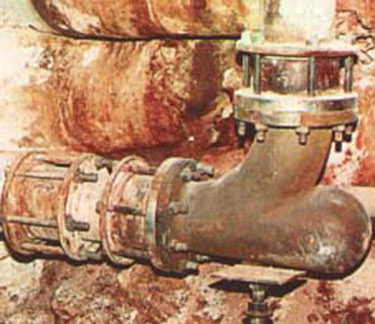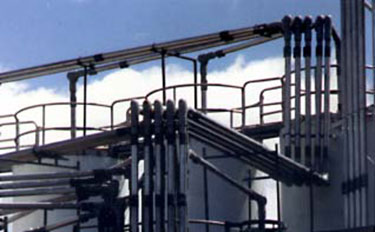September 22, 2022
Deflection Elbow Kits for Silo Top Fill Lines
BETHLEHEM, PA—New Smart Elbow® Deflection Elbow Kits from HammerTek® Corp allow direct replacement of silo top elbows and piping/tubing subject to abrasive wear, with all preparation done safely at ground level.
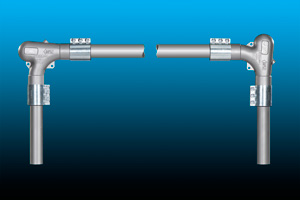
Each kit contains all components required to replace failing elbows, including two Smart Elbow® deflection elbows and all necessary piping/tubing, connectors and gaskets. All can be assembled on the plant floor prior to silo top installation, reducing personnel hazards associated with maintenance at high elevations in all weather conditions.
Silo top sweep elbows are prone to failure due to large volumes of conveyed material impacting the elbow wall at high speed to change direction, causing abrasive materials to wear through the elbow wall, resulting in blow-outs and lost production due to downtime.
The Smart Elbow® design features a spherical chamber that protrudes partially beyond the 90 degree flow path, causing a loose ball of airborne material to rotate in the same direction as the airstream that powers it, gently deflecting incoming material around the bend without impacting the elbow wall.
Socket style no-weld kits for all popular pipe and tube diameters include: two HammerTek elbows; one horizontal pipe or tube section; two vertical pipe or tube sections; and four sleeve couplings with reducer gaskets.
Flanged style kits for all popular pipe and tube diameters include: two ANSI flanged HammerTek elbows; one horizontal pipe or tube section with one welded ANSI flange; two vertical pipe or tube sections each with one welded ANSI flange; three loose ANSI flanges (for welding safely at ground level); and four gaskets.
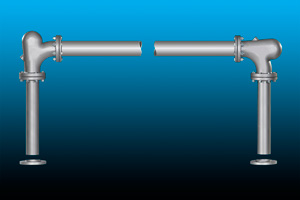
In addition to preventing elbow wear and failure, the design reportedly precludes friable materials from degrading and dusting, plastics from melting and forming streamers, and heat-sensitive materials from building up and plugging, while reducing pressure drop and offload times by up to 50%.
February 25, 2020
The Power of One
HammerTek is the only one-product company that offers specialty elbows for pneumatic conveying systems. Yes, our SMART-ELBOW® Deflection Elbows are available in cast iron, carbon steel, aluminum, stainless steel and other alloys; at 90- and 45-degree angles, and with either flanges or socket-weld ends, but it doesn’t change the fact that elbows are all we do! And it’s been that way since HammerTek’s beginnings back in the early 1980’s.
Over the years, we’ve seen ads for elbows from some multi-product manufacturers that show inaccurate renditions of material flow, or that make durability promises they probably can’t keep. These always get us to wondering: how well do they really know this vital conveying line component? This isn’t a little thing: ask anyone who has had to deal with an elbow failure on their pneumatic conveying line. Shouldn’t you put your process (and your reputation, and the safety of your employees and your plant) in the hands of the experts?
Behind each SMART-ELBOW is years of experience, both with convey line flow and material characteristics. Our varied elbow offerings show just how much we have developed and optimized our one-and-only product.
Don’t just take our word for it. Visit our Case History Page today and see what our customers have been saying about HammerTek!
January 24, 2020
Keeping Your Pneumatic Conveying System Running Efficiently
In conventional pneumatic conveying systems, materials impact the elbow wall at high speed to change direction. As a result, abrasive materials can wear through the elbow wall, fragile materials can break apart, and heat-sensitive materials can build-up and clog the elbow. When plastic pellets impact and heat the elbow wall, they often melt, forming streamers, angel hair and snakeskins.
A simple maintenance step to prevent these problems is to replace conventional sweep elbows, ceramic-backed elbows and plugged-tee elbows with deflection elbows that prevent material from impacting the elbow wall.
Deflection elbows, also known as vortex elbows, employ a spherical chamber that protrudes partially beyond the desired 90° or 45° pathway, causing a ball of material suspended in air to rotate. Since the ball of material rotates in the same direction as the airstream that powers it, incoming material is cushioned by the ball’s rotation, and is gently deflected around the bend. As a result, elbow wear, material degradation, and melting/plugging problems are virtually eliminated.
January 2, 2020
Happy “Pneu” Year from HammerTek!
Pneumatic conveying: you love it. No other conveying option comes close to moving large volumes of materials over long distances, completely and quickly. Whether in dense phase or dilute phase, pneumatic conveying tends to blow most other options away, both literally and figuratively.
So what’s the downside? Well, unless you have the rare system that runs in a straight line from intake to outlet, there will be a bend–usually multiple bends, in the convey line. The speed at which the material moves through these bends (a.k.a. elbows) generates friction that can reduce certain pelletized materials into fine streamers. These “angel hairs” sound innocent enough until you begin to add up the cost of cleaning them out of the convey line and the resultant high volume of unusable raw materials.
Even more likely to occur (especially if your material is even the least bit abrasive) is the elbow “blowing out” as a result of the high speed material striking its inside wall. This can be anything from a tiny pinprick hole, to a complete failure of the elbow. If there is a Murphy’s Law of pneumatic conveying, it probably states that the messier the material, or the harder to reach the elbow , or the more extreme the weather conditions of the surrounding environment, or the closer the proximity of an EPA agent to your site, the worse the blowout will be.
Why not make 2020 the year you end these aggravations by installing HammerTek’s SMART ELBOW® Deflection elbow into your pneumatic convey line? The Smart Elbow’s unique design features a spherical chamber that protrudes partially beyond the convey line, causing a ball of material suspended in air to rotate. Since the ball of material rotates in the same direction as the airstream that powers it, incoming material is cushioned by the ball’s rotation, and is gently deflected around the bend.
By preventing impact with the elbow wall, the Smart Elbow virtually eliminates costly elbow wear, material degradation, melting and plugging. Why not give yourself a happy and trouble free pneumatic conveying year? Contact HammerTek today and arrange for your FREE trial!
February 19, 2019
Comparison of Elbows for Pneumatic Conveying of Plastics
Below is a chart comparing various types of elbow designs and how they perform against specific elbow-related problems in a pneumatic conveying system. Each elbow is rated by various categories including degradation, noise levels, downtime and costs. They can range on a scale of excellent to poor in relation to how that specific elbow performs in each situation. 1171
November 29, 2018
Too Expensive Compared to What?
If two products look to be nearly the same, either in appearance or in function, most people will select the less costly option. “That other product was too expensive,” is a common refrain among decision makers, post-purchase. Selecting the less costly option can seem beneficial at the time, but when purchasing plant 1229
Generally, in a conveying system, the air in the center of the pipe moves faster than the air traveling closer to the pipe walls. This even, transitional flow helps to create an insulation around the wall of the pipe, reducing impact, noise and the generation of heat. Turbulence in the piping disrupts 1178
July 12, 2017
HammerTek® Smart Elbow® Cuts Offload Time
For many plants, efficiency is key for having a profitable facility and system that runs smoothly. A lot of times when shipments come in, the pace of getting material off the truck or rail car can be slow. This is commonly due to waiting for the system to take all the material and transferring it to the convey line. 1177
In a pneumatic conveying system, fines, streamers, snake skins and angel hair are common issues associated with the transferring of plastic pellets. This damage to conveyed material typically creates problems within the system.
When heat-sensitive pellets enter the conveying system, they begin moving at a rapid rate. 1106
Powder and Bulk Engineering’s PBE-News’ Ask an Expert feature addressed options to mitigate erosion in pneumatic conveying lines. Ray Cocco from Particulate Solid Research Inc. mentions various methods of reducing erosion. One suggested method is replacing the type of elbow used in the system. 1101
December 15, 2016
HammerTek® Hammerloy™ Series a Perfect Fit
Blowouts aren’t just costly due to lost productivity and extensive cleanup; they often carry substantial health risks and safety concerns from spilled material and environmental conditions.
This was certainly the case with the Upper Occoquan Sewage Authority (UOSA). 958
November 23, 2016
Pneumatic Deflection Elbows Cut Wear, Dust, Offload Time for Bulk Project Contractor
Robert Ober & Associates is a specialty design/build firm that serves an international client base for bulk material handling projects that range from $25,000 retrofit contracts to $25-million turnkey plant projects. The company’s early focus on pneumatic material handling for concrete plants has grown to include a wide range of material handling, weigh batching, and powder blending systems in mining, grain, fertilizer, food, fly ash, plastics, 927
November 17, 2016
Smart Elbow® Deflection Elbows Withstand the Test of Time
Five years after we did a case study on the 120 HammerTek® Smart Elbow® deflection elbows installed at RheTech, Inc., we checked in with them to find out how the elbows were holding up. RheTech is a designer, manufacturer and marketer of proprietary thermoplastic 922
October 20, 2016
Eliminate Down Time with the Smart Elbow® Deflection Elbow
Your conveyor system is your company’s lifeline. Anything — make that everything — you can do to keep it performing at peak capacity will carry through to your bottom line. There is nothing “routine” about routine maintenance. When your system is down for any reason, 919
September 30, 2016
Smart Elbow® Consistently Outperforms
A company that produces pipe was having some troubles of its own before the HammerTek® Smart Elbow® deflection elbow solved its problem.
Rensselaer Plastics Co. of Rensselaer, Ind., produces PVC piping products for the plumbing trade, with annual sales in the $40 million range. One process at the plant uses a pneumatic conveying system to transfer resin and pellets from storage hoppers to pipe extruders, and therein lay the plant’s Achilles Heel.
September 19, 2016
Smart Elbows® Perfect for Pulp and Paper Industry
August 15, 2016
Smart Elbow® Saves Money — and Space
HammerTek® Smart Elbow® deflection elbows can offer benefits beyond solving manufacturing problems. When Miller Brewing Company needed a space-saving design solution, they found the elbows solved their predicament and saved them money in the process.
908
July 28, 2016
Smart Elbow® Cleans up Safety Issues
When the Upper Occoquan Sewage Authority (UOSA) experienced a blowout, it caused not only costly and time-consuming downtime and cleanup, but also health risks and safety concerns. Thanks to the HammerTek® Smart Elbow® deflection elbow, the wastewater treatment plant hasn’t had an elbow failure again since installation. Click here to read the full case study.
902
The HammerTek Smart Elbow® deflection elbows reduce the costly headaches of manufacturing plug-ups. Learn how we solved this problem for Fiberglas Canada by reading the full case study here.
899
June 29, 2016
HammerTek Smart Elbow® Sweeps the Competition
RheTech, Inc. was all too familiar with worn out elbows in their plant.
When Gary Wright, Director of Plant Engineering, had one of the HammerTek® Smart Elbow® deflection elbows they had installed a year earlier pulled to check for wear and tear, he assumed it would require considerable repair, if not replacement. “After one year in service, we could still see the casting marks,” said Wright. “By now, we would have been through four or five sweep elbows and 12 rolls of duct tape.” He added, “We’re impressed.”
Five years later, we checked back with RheTech to see how the Smart Elbow units were holding up. None of the 170 Smart Elbow deflection elbows installed had worn out or been replaced since the installation six years earlier. Click here to read the full case study. 895


